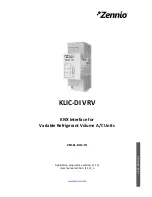
Appendix A – EDID Programmer
63
Epica DGX 144 Instruction Manual
Appendix A – EDID Programmer
EDID Programmer software is provided for re-programming the EDID EEPROM chips on the
Epica DGX 144 DVI and HD-15 RGBHV input boards if necessary. This software is available (along
with board configuration software) on the
AMX AutoPatch CD
or at
www.amx.com
.
Note:
Board configuration software is used to adjust the source signal for optimal display at
the destination. For information on the DG_HD15 Wizard, see the “Epica DGX 144 HD-15 RGBHV
Input Board” chapter on page 54. For information on other types of board configuration wizards, see
the specific accessory module’s documentation.
EDID Overview
EDID (Extended Display Identification Data) is a data structure established by the Video Electronics
Standards Association (VESA) to enable plug-and-play support by enabling easy configuration of
a computer’s graphics subsystem based on the capabilities of the attached display device.
EDID information includes items such as the following:
Manufacturer’s name
Product type
Supported video resolutions and refresh rates
Color space and filter chromaticity
Detailed timings
When a computer is directly connected to a display device, it can use the display device’s EDID
information to determine an initial compatible video signal to send. With the computer’s display
controls, the user can modify this selection to another compatible signal based on the provided EDID
information.
With DVI (which requires EDID on the display devices), using EDID information has extended beyond
computers to other source devices, such as DVD players. As long as the source device sends a
compatible signal, the plug-and-play feature will work.
Matrix Switchers and EDID
Matrix switchers, such as the Epica DGX 144, provide the ability to route one source signal to many
potentially different types of display devices. Through the use of compatible DGX SC Fiber Receivers
featuring SmartScale™, in almost all cases, incompatibilities between source device resolutions and
displays are automatically resolved as each receiver independently scales each source device’s video to
the display’s native resolution.
In cases where local DVI outputs are used and a resolution incompatibility exists (or if a source device
desires a specific resolution), the DGX DVI input board and the DGX HD-15 RGBHV input board are
provided with the ability to update the EDID emulation file (by updating each input’s EEPROM chip)
which comes pre-loaded with an AMX AutoPatch EDID set.
This EDID set consists of some of the most common EDID settings in use today, including all VESA
Established Timings encompassing 8 resolutions at a variety of refresh rates and 8 additional Standard
Timings encompassing 8 resolutions and refresh rate combinations (for DVI timing details, see page 60;
for RGBHV, see page 52). In many cases, the matrix switcher can be used straight out of the box with no
adjustments (see “Determining the Need for EDID Programming” on page 64).
The EDID Programmer software has been provided for cases where additional in-field programming of
the EDID chips is needed. The EDID Programmer can be used for the following:
Reading and saving EDID data from a device
Writing EDID data to an AMX AutoPatch matrix switcher’s input connector’s associated
EDID EEPROM
Summary of Contents for Epica DGX 144
Page 10: ...Notices 6 Epica DGX 144 Instruction Manual ...
Page 20: ...Overview and General Specifications 16 Epica DGX 144 Instruction Manual ...
Page 48: ...Installation and Setup 44 Epica DGX 144 Instruction Manual ...
Page 54: ...Epica DGX 144 SC Fiber Boards 50 Epica DGX 144 Instruction Manual ...
Page 72: ...Appendix A EDID Programmer 68 Epica DGX 144 Instruction Manual ...
Page 82: ...Appendix B Managing Configuration Files 78 Epica DGX 144 Instruction Manual ...
Page 106: ...Appendix E Board Replacement 102 Epica DGX 114 Instruction Manual ...
















































